10 Tips for making kick ass burgers
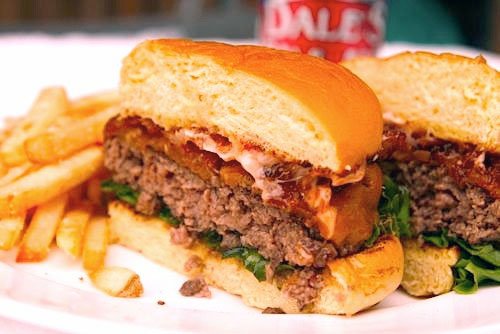
The tips I'm setting out here are ones that, with very few exceptions, apply universally to all hamburgers, regardless of style. Thus, one thing you will not find in this list is specific cooking instructions in terms of heat source, strength, and timing. As far as taking a formed patty from raw to cooked, there are no hard and fast rules that apply in every situation.
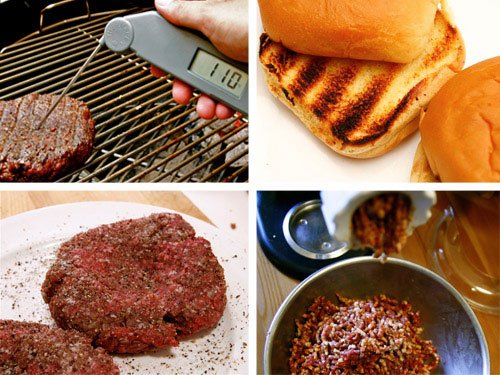
1. GRIND YOUR OWN BEEF
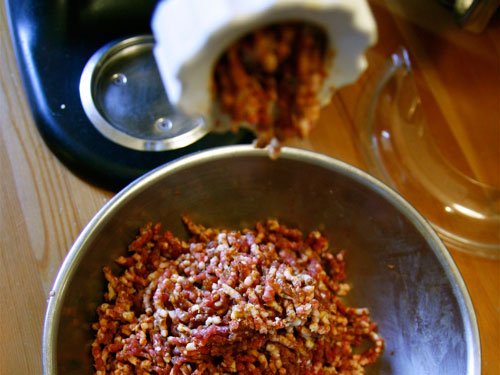
Buying store-bought ground beef is a crap shoot. You're never quite sure when it was ground, what part of the cow it came from, or even how many different cows are in the package. Not to mention baddies like e.coli, freshness issues, rough handling, and tight shrink-wrap packaging that can lead to leaden patties.
If you've never ground beef yourself, the task may seem daunting at first, but take it from me: once you grind, you never rewind.
A heavy-duty dedicated electric meat grinder is fantastic, but impractical unless you own a restaurant or hunt. I use the KitchenAid attachment—with good results—although even a decent hand-cranked model will deliver beef worlds better than store-bought.
Don't have either? You can use food processor. Just dice your meat into 1-inch chunks, spread them on a rimmed baking sheet, put them in the freezer for about 15 minutes until they're firm but not frozen, then working in 1/2-pound batches, pulse the meat to the desired grind size (about 10 to 12 one-second pulses).
Grind your own beef, and not only do you control everything from the meat blend, to the grind size, to the fat content, but even better, you get to tell people that you grind your own beef.
2. KEEP EVERYTHING REALLY COLD
Until your burgers are fully formed, heat is their mortal enemy. Warm fat is soft and pliable, and tends to stick to your hands and work surfaces. And if that fat's on your hands, then it ain't in the burger.
When grinding your own meat (and I certainly hope you are), make sure that everything—the feed shaft, the grinding blades, the plate, and the meat—is well chilled to avoid fat smearage. I keep my meat grinder stored in the freezer so I'm ready to grind at moment's notice. Pat La Frieda has yet to make an accidental delivery to my door, but when he does, I'll be ready for him.
3. WEIGH AND SIZE YOUR PATTIES
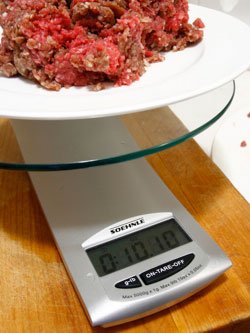
Weighing your meat as you divide it and measuring your patties as you form them will ensure that all your burgers will be uniform in shape and size, which in turn will guarantee that they all cook at the same rate. A scale and a good eye are all you need (though the truly OCD like myself will want a ruler as well).
Bonus tip: if you're into big, fat patties (we're talking 6 ounces or more), you must have experienced the dreaded "meatball syndrome" at some point. You know—when your patty bulges as it cooks, turning it into an impossible to eat football-shaped blob? Form your patties with a slight dimple in the center, and they'll maintain their shapely disk-form as they cook.
4. USE A THERMOMETER
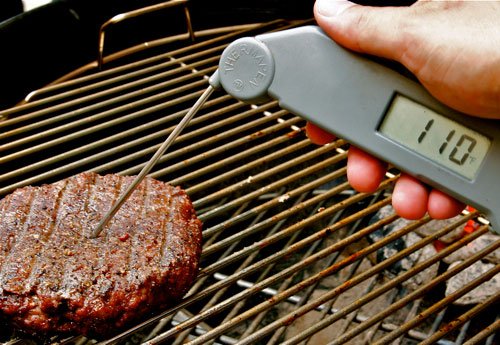
A burger starting to edge up on medium-rare.
Sure, you can be all macho and try and gauge a burger's doneness by poking at it with your finger (if you can do that with 100% accuracy, you are a far better cook than I), or you can suck it up and buy yourself a good instant read thermometer.
The Splash-Proof Super-Fast Thermapen by Thermoworks ($96) is the cadillac of thermometers and will tell you in three seconds or less whether your créme Anglaise is going to thicken or if your oil is hot enough for your fries. But even an inexpensive one ($16.95) will do the job in a pinch, albeit slightly slower.
With really large burgers (8 ounces or more), some carryover cooking may occur, so pull them off a few degrees before optimum, and give them some time to rest. I aim for a medium-rare 130°F, but I understand that inexplicably, not everybody prefers optimizing juiciness and beefiness in their burgers.
Here's a rough temperature guide:
120°F and below for rare (red/raw in the center)
130°F for medium-rare (pink and warm)
140°F for medium (totally pink, starting to dry out)
150°F for medium-well (grayish pink, significantly drier)
160°F and above for well done (completely gray, very little moisture)
5. SEASON LIBERALLY
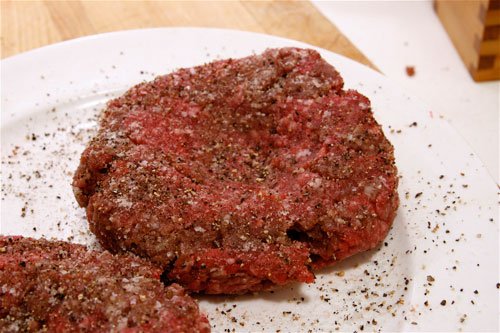
This is what a well-seasoned patty looks like.
No matter how carefully you select your meat blend, without salt and pepper, you're better off dining with the King or the Clown, who, despite their significant shortcomings, at least understand the benefit of a little sodium chloride. Freshly ground black pepper from whole peppercorns is a must—it's far more flavorful than the insipid pre-ground powder.
Whatever people say, kosher salt is not more or less salty by weight than table salt. I like to use it because its large crystals are easy to pick up with your fingers. Take a large pinch of kosher salt and hold it at least eight inches above the patties as you sprinkle to ensure even coverage.
And to all you New Yorkers: don't let the damn city tell you how your food should taste. Season your burgers as liberally as you'd like. You can eat a salad tomorrow.
6. DO NOT SALT BEEF UNTIL PATTIES ARE FORMED
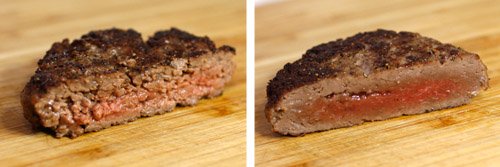
An unsalted vs. salted patty.
I repeat: do not salt your beef until the patties are formed. Salt will dissolve muscle proteins, which subsequently cross-link, turning your burgers from moist and tender to sausage-like and springy. The effect is dramatic. Need proof? See it here.
The best time to season your burgers is within minutes of the time their gonna hit the grill or griddle. Salt starts affecting meat—dissolving proteins, drawing out moisture—the moment it comes in contact with it, adversely affecting the exterior texture of your patties. And that's not a good thing.
7. FLIP YOUR BURGER AS OFTEN AS YOU'D LIKE
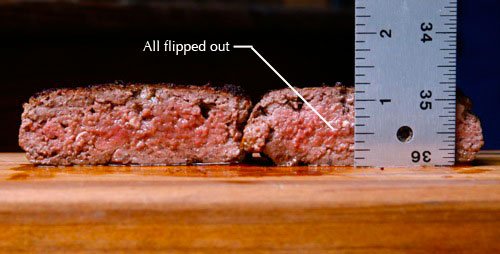
An oft-flipped burger cooks more evenly.
How many times have you read that you should only flip your burgers once while they are cooking? Well forget about it! We recently proved that the nervous flippers are actually right. Flipping your burger repeatedly (as often as once every 15 seconds) encourages faster, more even internal cooking, shaving off as much as 1/3 of your grill time.
In the end, the difference is not particularly great, so there's no need to go crazy. Who wants to—or can—flip a grillful of burgers constantly? But next time you come across one of those backyard grill-nazis (you know the type) who absolutely insists that one flip is the way to go, just smile, nod, and let him cook the way he wants to. Rule one of grilling is never question the guy with the spatula.
But do make sure to quietly revel in your superior knowledge and maybe make fun of him behind his back.
8. DON'T FUTZ WITH YOUR MEAT
Working the meat unduly will cause proteins to cross-link with each other
Despite outward appearances, ground meat is not dead. From the moment you lay your hands on it, it is changing dynamically, reacting to every knead, every sprinkle of salt, and every change in temperature. Working the meat unduly will cause proteins to cross-link with each other like tiny strips of velcro, making your finished burgers denser and tighter with every manhandling of the grind.
For the most tender burgers, grind your meat fresh, and form your patties as tenderly as possible. For griddled patties with superior nooks and crannies for cheese-catching, I sometimes like to grind my meat directly onto a sheet tray and gently coax it into patties without ever picking it up until just before I cook it. Superb.
There's a corollary point here: adding junk like onions, herbs, eggs, breadcrumbs, anything to your ground meat not only forces your to over-handle the mix, but it instantly relegates your burgers into the "meatloaf sandwich" category. If you absolutely must add junk to your burgers—and with a good, well-selected meat blend, there's really no need to—mix it with the cubes of beef prior to grinding (but don't add the salt yet!), so that it can be evenly distributed without the need to overwork the beef afterward.
9. CHOOSE YOUR BUN WISELY

A grilled Martin's Potato Roll.
Buns come in all shapes, sizes, densities, and flavors. Make sure you've got the right one for the job at hand.
For smaller, thinner patties, like a good Shake Shack-style griddled burger or small Northern Jersey-style sliders, soft, sturdy, and slightly sweet Martin's Potato Rolls set the benchmark, although any soft, squishy, standard-issue supermarket bun will do.
A bigger, pub-style burger can overwhelm a soft bun with juices, soaking through and dissolving the base before the burger even hits your table. Toasting the bun can mitigate some of these effects, but for the most part, you're better off selecting a sturdier roll, or if you've got one nearby, a custom burger bun from an artisan bakery. Brioche has its adherents, but I prefer my buns to be a little more bland, so as not to compete with the flavor of the beef.
Do avoid anything with an overly chewy crumb or a tough crust, unless you want your burger to suffer from the dreaded backslide.
10. DON'T LET ANYONE TELL YOU WHAT TO PUT ON IT
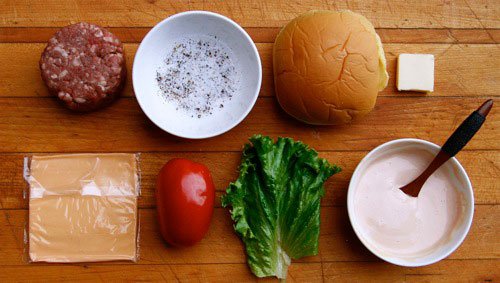
A standard selection of Fake Shack ingredients.
I like American cheese, raw yellow onions, pickles, special sauce when applicable (mayo when not), and tomatoes, but only when they are very very good. My wife likes American cheese, grilled onions, and a ketchup/mayo blend.
Am I right? Of course I am.
Is she right? Well, of course she is.**
**At least this time.
The point is, don't let anyone tell you what should and shouldn't go on your burger. If you want to go commando, do it with gusto. Do you like pecorino, pimentos, and peanut butter on your patties? Yes? Well, pile it on.
Then get your head checked. Really.

Obviously, this is only the tip of the iceberg. Burgers are an endlessly fascinating subject, and there's always more to learn. At least I hope so, if only for my column's sake.
Any other good burger tips out there that I missed?
Now I need to bbq a midnight hamburger!
No upvote because you didn't credit seriouseats.com...
http://aht.seriouseats.com/archives/2010/03/the-burger-labs-top-ten-tips-for-better-burgers.html
Best Korean Restaurant in the UAE
https://en.wikialpha.org/wiki/Mukbang_Shows_Restaurant_Korean_BBQ_and_Seafood
Hi! This post has a Flesch-Kincaid grade level of 6.9 and reading ease of 76%. This puts the writing level on par with Stephen King and Dan Brown.
Keep up the great work @overlord
Upvoted